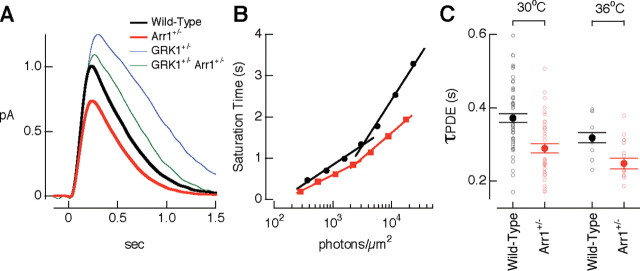Figure 4.
Decreasing arrestin1 concentration shortens Rh* lifetime. A, Mean estimated single-photon responses from wild-type (black) and Arr1 +/− (red) rods at 30 ± 1°C. Responses of GRK1 +/− and GRK1 +/− Arr1 +/− rods from Figure 3 are shown for comparison. B, Representative Pepperberg plot for a wild-type rod and an Arr1 +/− rod. The saturation time for the wild-type rod increased more steeply with flash strength than that of the Arr1 +/− rod at every flash strength measured. The time constant for PDE activity decay was 420 ms for the wild-type rod and 310 ms for the Arr1 +/− rod. C, τPDE for populations of wild-type and Arr1 +/− rods at 30 ± 1°C and 36 ± 1°C. At 30°C, τPDE was 370 ± 10 ms (mean ± SEM) for wild-type rods (n = 52) and 290 ± 10 ms for Arr1 +/− rods (n = 41). At 36°C, τPDE was 320 ± 10 ms (mean ± SEM) for wild-type rods (n = 15) and 250 ± 15 ms for Arr1 +/− rods (n = 18).

